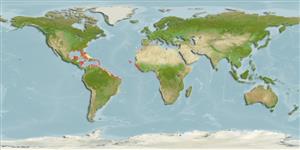Issue
This species is synonym of Kyphosus vaigiensis (Quoy & Gaimard, 1825) according to Knudsen et al. (2013: Ref. 95491). The species page will be removed if proven to be not valid; please send references.
Environment: milieu / climate zone / depth range / distribution range
Écologie
marin récifal; profondeur 1 - 15 m (Ref. 95687). Subtropical; 42°N - 34°S, 98°W - 23°E
Western Atlantic: Cape Cod, Massachusetts (USA) to Brazil. Also found in Argentina (Ref. 86336). Eastern Atlantic: Madeira Island (Ref. 74541), São Tiago Island (Cape Verde) and Angola (Ref. 7373); Sao Tome Island (Ref. 30488).
Taille / Poids / Âge
Maturity: Lm ? range ? - ? cm
Max length : 90.0 cm SL mâle / non sexé; (Ref. 6547); common length : 45.0 cm TL mâle / non sexé; (Ref. 3725); poids max. publié: 3.9 kg (Ref. 40637)
Épines dorsales (Total) : 11; Rayons mous dorsaux (Total) : 13 - 15; Épines anales: 3; Rayons mous anaux: 12 - 13. grey with longitudinal brassy stripes on body and 2 brassy horizontal bands on head. Opercular membrane slightly pigmented. Each jaw with a regular row of close-set, strong, incisor-like, round-tipped teeth of a peculiar hockey-stick shape, their bases set horizontally, resembling a radially striated bony plate inside mouth (Ref 52729).
Inhabits shallow waters, especially over rocky bottoms in coral reef areas; also among floating Sargassum weeds (Ref. 3725). Feeds on algae including much Sargassum (Ref. 5521). Marketed fresh (Ref. 3725).
Life cycle and mating behavior
Maturities | Reproduction | Spawnings | Egg(s) | Fecundities | Larves
Robins, C.R. and G.C. Ray, 1986. A field guide to Atlantic coast fishes of North America. Houghton Mifflin Company, Boston, U.S.A. 354 p. (Ref. 7251)
Statut dans la liste rouge de l'IUCN (Ref. 130435)
Menace pour l'homme
Harmless
Utilisations par l'homme
Pêcheries: intérêt commercial mineur; pêche sportive: oui
Outils
Articles particuliers
Télécharger en XML
Sources Internet
Estimates based on models
Preferred temperature (Ref.
123201): 23.1 - 28.1, mean 27.2 °C (based on 980 cells).
Phylogenetic diversity index (Ref.
82804): PD
50 = 0.5000 [Uniqueness, from 0.5 = low to 2.0 = high].
Bayesian length-weight: a=0.01585 (0.00753 - 0.03337), b=3.02 (2.83 - 3.21), in cm total length, based on LWR estimates for this species & (Sub)family-body (Ref.
93245).
Niveau trophique (Ref.
69278): 2.0 ±0.0 se; based on diet studies.
Résilience (Ref.
120179): Faible, temps minimum de doublement de population : 4,5 à 14 années (Assuming tm>4).
Fishing Vulnerability (Ref.
59153): High to very high vulnerability (66 of 100).
Nutrients (Ref.
124155): Calcium = 22.2 [7.9, 36.8] mg/100g; Iron = 0.517 [0.274, 0.887] mg/100g; Protein = 19.3 [18.1, 20.6] %; Omega3 = 0.129 [0.067, 0.243] g/100g; Selenium = 16.3 [6.9, 38.1] μg/100g; VitaminA = 29.4 [7.0, 115.5] μg/100g; Zinc = 0.995 [0.647, 1.519] mg/100g (wet weight);
